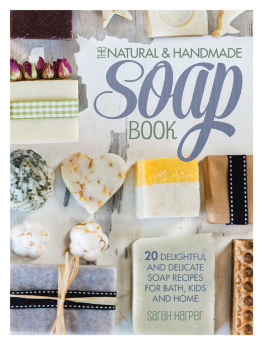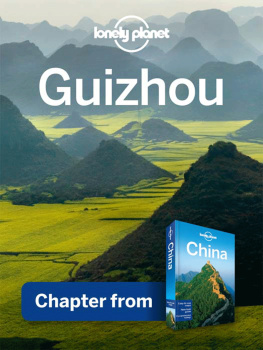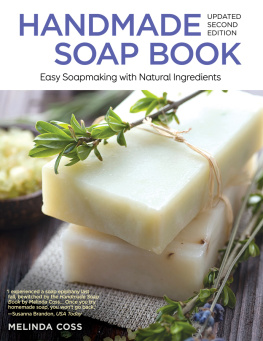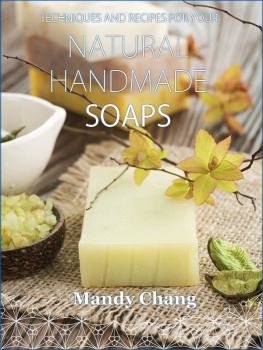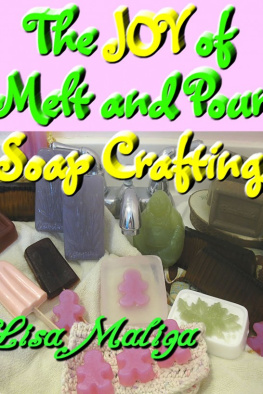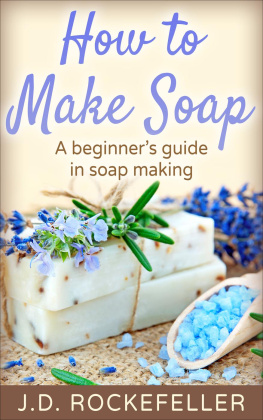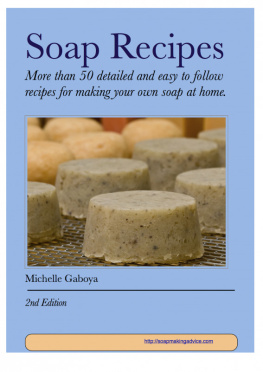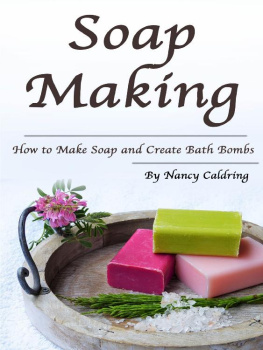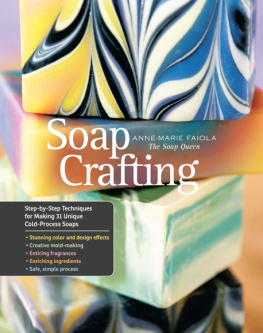Contents
Introduction
For as long as I can remember I have been fascinated with making my own natural products. My early forays into perfumery consisted of a collection of rose petals from my grandfathers rose bed squirrelled away, and mixed with water in an old jam jar on a sunny day. These were not successful, but enabled me to while away a few hours in the sunshine as a child!
My early inspiration was a marvellous book of my mothers entitled The Natural Beauty Book by Clare Maxwell-Hudson. Within it I found recipes for skin creams, lip balms and face masks; all made using ingredients found in the kitchen or garden. I still have that book and I like to think that it started me on the path to my career and a way of life that I love to share with others.
Although I made creams and lotions for years, it was only nine years ago that I discoveredsoap making through another book given to me by a friend. Traditional cold process soap is a far cry from the factory-made soaps that I remember as a child, and once I started making my own I knew there was no going back.
The History of Soap
Soap has a long and fascinating history, and certainly in Europe the Celts were known to use a substance made from animal fats and plant ashes for bathing and washing. The Romans originally used soap made from goat tallow and wood ashes and there is evidence of an entire soap factory under the ruins of Pompeii, complete with finished bars. Soap has been made in Europe since the 13th century, and the countries with access to olive oil were able to produce superior soap for personal bathing. Northern France and England only had access to animal tallow and this produced an inferior bar, mainly used for laundry and textile cleaning.
Soap was originally used for personal bathing, laundry and all other washing until 1916, when the First World War led to a shortage of fats that inspired the production of the first detergents. Detergents have now replaced soap in all laundry and cleaning products, and many body care products are made from detergents rather than soap. Nowadays there are shelves and shelves of shower gels, body washes and hand cleansers, and very little in the way of soap sold in supermarkets.
What is Soap?
Soap is made by combining oils with sodium hydroxide (caustic soda) if you know your school biology: acids and bases to make a hard product that cleanses with a pH of about 8.5. The reaction that takes place when oils and sodium hydroxide are combined in water at a particular temperature is called saponification, and this is what produces the end product. A harsh alkali combined with oils makes a mild and creamy lathering product that is gentle on the skin and has none of the caustic catalyst left.
In terms of how soap works, when water is added to it and agitated it makes a lather, which suspends dirt in it and allows it to be washed away. There are many people who feel that hand soap is unhygienic because of this, and there has recently been a huge shift towards hand pump detergent soaps with antibacterial products added. Sadly these are contributing to the problem of antibiotic-resistant bugs and are not any more hygienic. Dirty hands still have to touch the pump in the same way that they do the soap, except all the dirt is left on the pump rather than washed away with the soap.
In its most basic form, soap is a combination of simple ingredients: once you have mastered the basics there is a vast potential to change the texture, colour, shape and fragrance to make your own personalized products that are suitable for a variety of uses.
Why Make Soap?
I started soap making because I was becoming increasingly sensitive to detergents and commercial cleaning and body care products. Even commercially-made soap lacks glycerine, which is a natural by-product of the process and enables soap to soothe and clean without irritation.
Glycerine is extracted in commercial soap making and sold separately for use in cough medicines and home remedies. Traditional cold process soap making retains this marvellous ingredient, and this is one of the many reasons why I love it.
About This Book
This book aims to give you a thorough grounding in the basic and essential techniques that are needed to make a really good bar of soap. Each project builds on previous techniques and allows you to learn at a pace that consolidates your knowledge. In addition to old-fashioned soap-making techniques, you will also learn about melt and pour soap, which is a quick and safe method of soap making without the use of caustic chemicals, and is brilliant for children to learn.
The book is divided into three sections. Luxurious Lathers will introduce you to a wide variety of irresistible soaps for every occasion, made by combining basic soap recipes with exciting botanicals, fragrances and colours. Messy Play provides a range of fun soap products to make with children, to get them started on the path of natural product making. While soap is primarily used for washing the body, it has a plethora of other uses around the home, and Natural Living explores the ways that you can use up your soap scraps with other natural ingredients to make your own cleaning products, dishwasher tablets, washing powder and more.
Once you have made your soap you will want to show it off to its best advantage, and finally you will find ideas for how to package and wrap your homemade items for gifts or to sell. Once you have mastered the basics, there are plenty of top tips on troubleshooting and advanced techniques to inspire you.
I hope that you enjoy this book and it will bring you as much joy as soap making has brought to me over the years.
Soap-Making Essentials
Soap making is very much like cooking and you may already have most of the equipment you will need lying around the house. Once you start using something for soap making, keep it just for that to avoid transfer of chemicals and essentials oils to your cooking equipment.
Equipment and Materials
Here is a list of basic equipment and materials that you will need to have at hand during the soap-making process:
1. Heavy-duty rubber gloves, apron, safety goggles and long-sleeved top: this will protect the user from caustic spills and fumes.
2. Vinegar: essential to have on hand at all times. It neutralizes the sodium hydroxide (caustic soda) acid neutralizes an alkali and if you manage to get some caustic liquid or raw soap on your skin, a quick spray followed by a wash will prevent any burns. If, like me, you have pets and children, cleaning the floors and surfaces with vinegar alleviates any worry about unknown spills.
3. Stainless steel saucepan: for making the soap in (3 litres (5 pints) minimum). Do not use any other types of metal, such as aluminium, as it will react with the soap.
4. Heat source for melting oil: your hob (stove) or a small electric camping stove that can be used anywhere.
5. Moulds: pour raw soap into these to create the basic shape of your finished soaps. There are many types available, ranging from cardboard lined with greaseproof (wax) paper to custom-made silicone moulds that allow easy soap release. The best moulds are silicone or heavy-duty plastic, which can be lined or greased. If you are a keen recycler you can use drainpipes, juice boxes, empty cardboard, plastic pots and cake moulds. There are various websites selling commercial moulds that allow you cut uniform bars and novelty silicone moulds (see ). Generally, the larger the amount of soap you make at once, the better the end results. Although it is tempting to pour soap into pretty little silicone-shaped moulds, they lose heat too quickly and saponification will take much longer. To create small bars, wait until you make a batch in a large mould and pop the smaller moulds on top of the large mould before insulation to take advantage of the extra heat generated.

